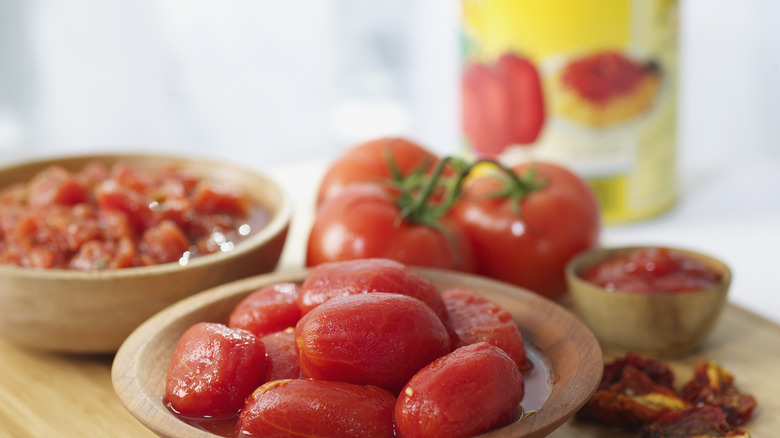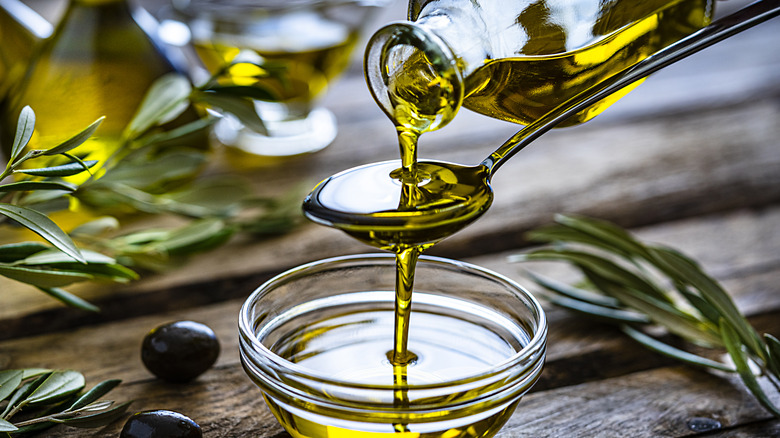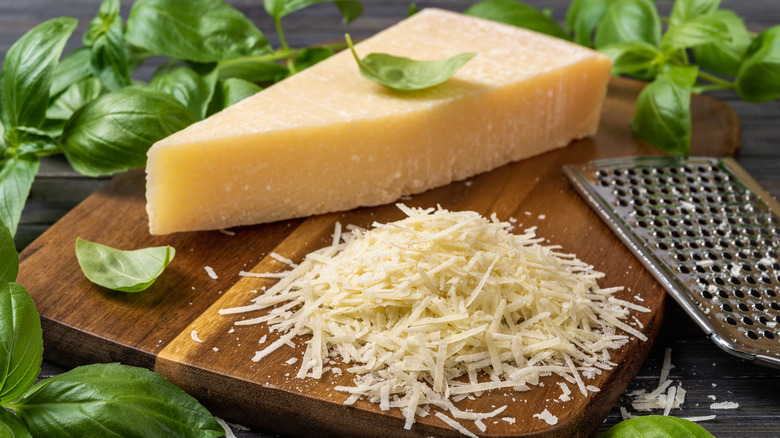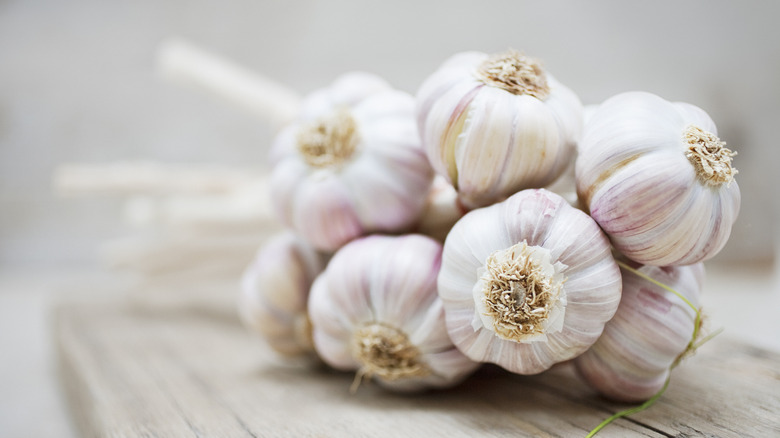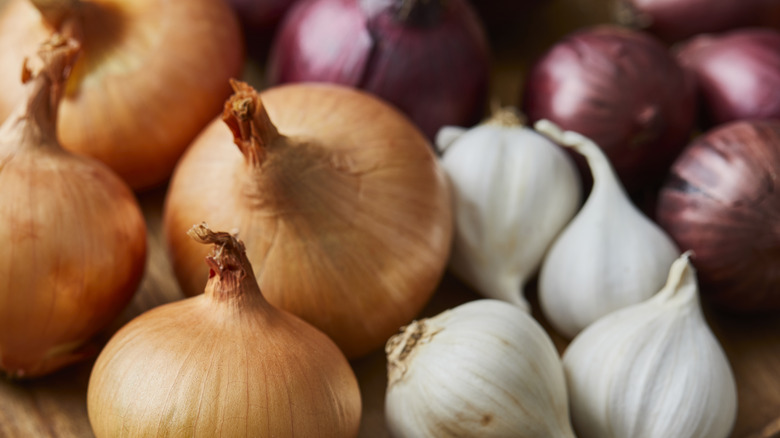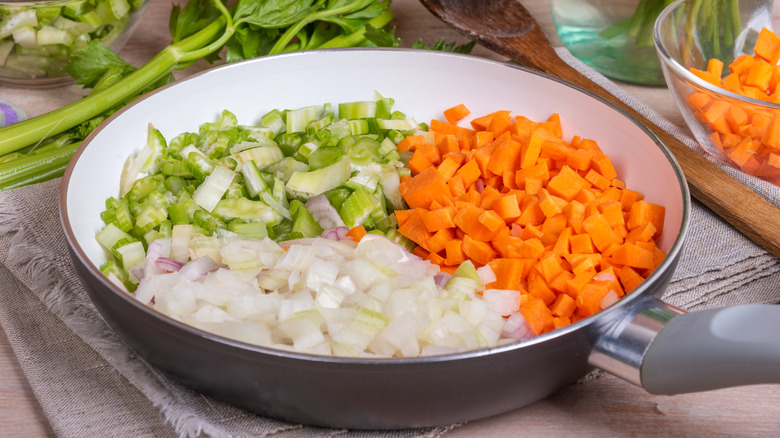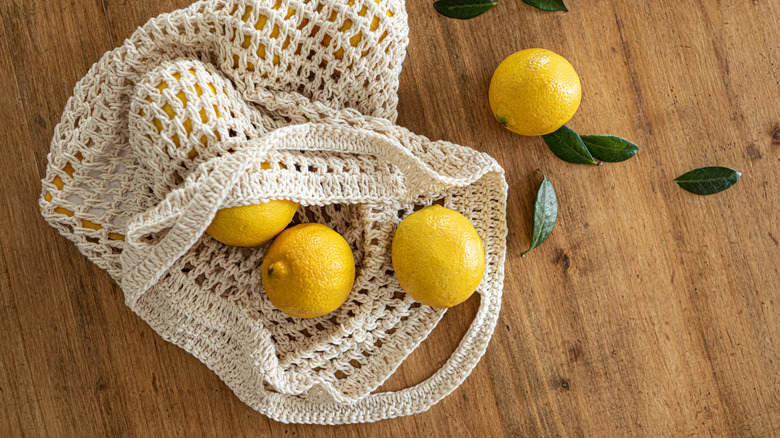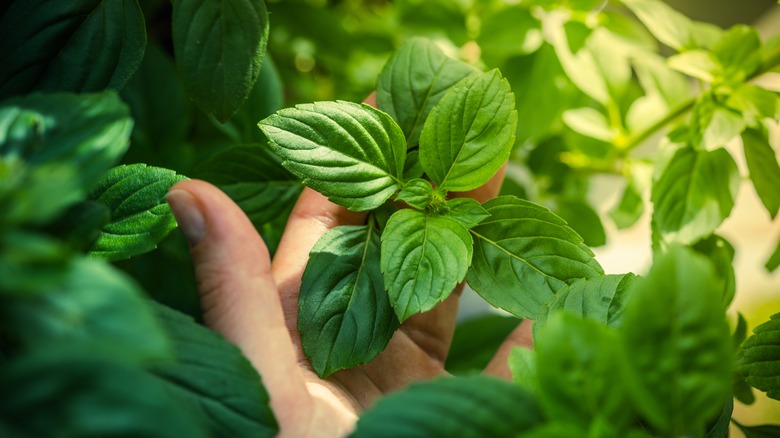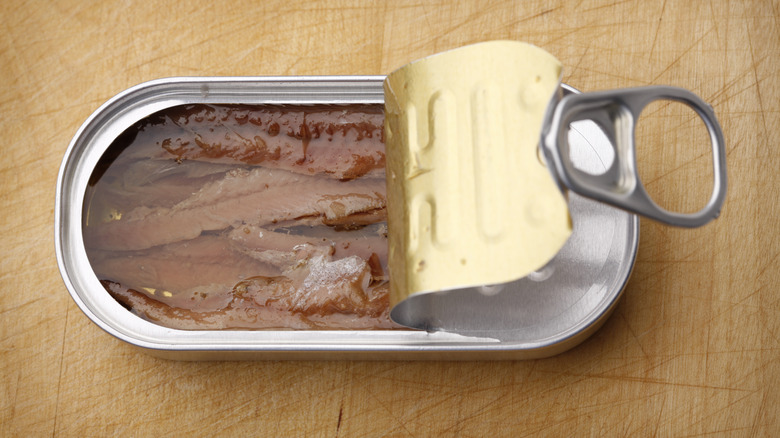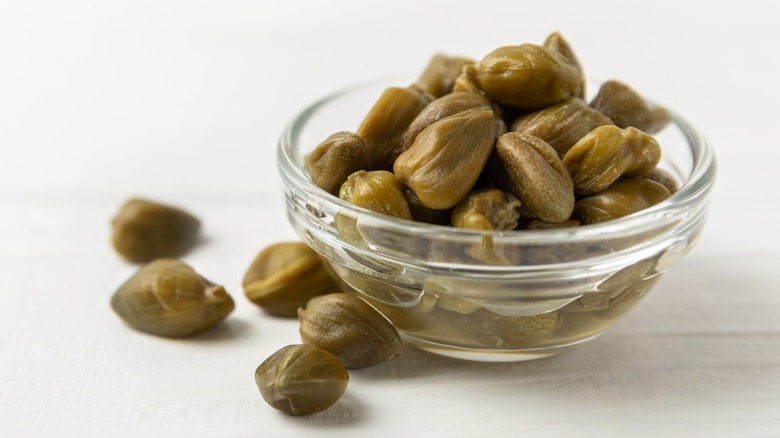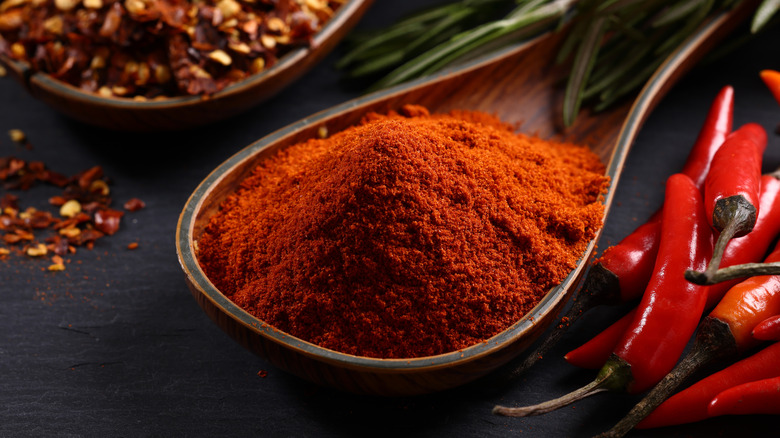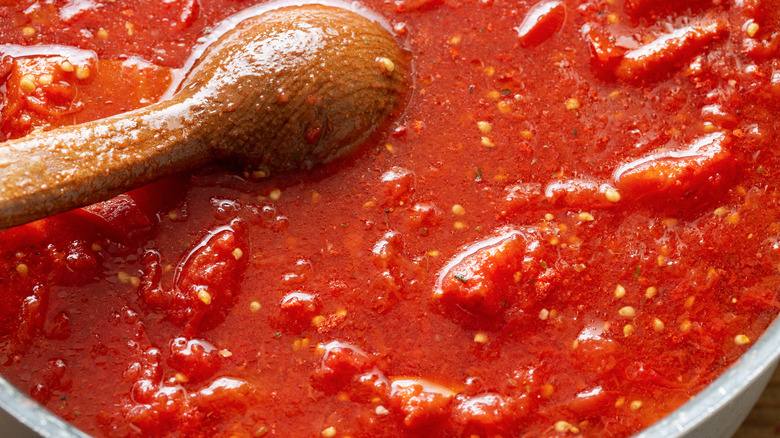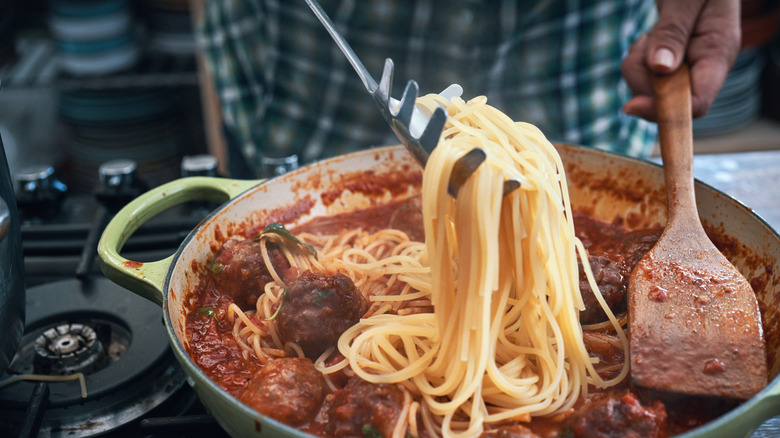15 Secret Ingredients Your Store-Bought Tomato Sauce Needs
Let's face it: Sometimes the tomato sauce you find at the store is just plain uninspiring. Now, when talking about "tomato sauce," most home cooks mean jarred tomato pasta sauce, as plain tomato sauce is simply pureed cooked tomatoes, and no one expects it to taste like anything other than its sole ingredient. When you buy a tomato pasta sauce, though, it's frustrating to come home with a jar of something you hope will make your weeknight easy and discover that all it has done is make your cooking more boring. No, thank you.
The good news is that you can take steps to ensure that even the least mouth-watering store-bought tomato sauce has some zing. Of course, most home cooks already know that you can jazz up a sauce with the addition of some meat or mushrooms. After all, what marinara isn't better with ground beef or creminis swimming in it?
The real trick is knowing what you can add to correct the flavor of an unbalanced tomato sauce, whether that's too sweet, too salty, too spicy, too watery, or too anything else. Accordingly, here are 15 ingredients (or ingredient pairs) to try at home and tips on when to add them to your store-bought pasta sauce. You needn't add them all at once, but rather as required based on the issues your jarred sauce presents. Keep them in mind when cooking your own sauce, as well!
1. Fat
Adding butter, olive oil, or even lard to your tomato sauce is one of the best ways to make it stand out. Fat emulsifies liquids, meaning it binds them together with the fat as a connector, as when you mix oil and vinegar for salad dressing. This physical property gives sauces the oomph needed to stick to your pasta instead running off into the bottom of the bowl.
For that reason, this should be your immediate go-to when your sauce is too runny. Simply add a few pats of butter or a dash of olive oil right at the end, whisk up, then wait for it to emulsify for a creamier, thicker result. Lard is also fantastic in tomato sauce. This works just as well for marinara and pizza sauce, and if you're going all the way, for plain tomato sauce too. The other way to add fat is to use a good amount of it while cooking up veggies before adding your sauce (more on that below).
2. Dairy
If the idea of pure fat lumps is off-putting to you, or if you simply don't have access to it for some reason, you can add dairy instead for that rich mouthfeel. Cream works well, though you only need a little bit to get the job done — about ½ cup for one jar of tomato sauce. Don't just dump cream in toward the beginning of prep, though, as it's likely to curdle when it comes into contact with the acid in tomatoes. Instead, heat the cream and the tomato sauce separately, then slowly add the tomatoes to the cream, not vice versa, right at the end.
Parmesan is also a great form of dairy. When grated finely, it will melt right into your doctored sauce. Hard cheese such as Asiago and Pecorino will also do the trick, as will aged white cheddar. You can even cook hard cheese rinds right in the sauce if you have time to simmer it for at least 30 minutes. This both imparts a deep flavor and helps use up those otherwise head-scratching ends and pieces. However, if you're using grated cheese, you'll want to add it at the end to avoid curdling.
3. Sugar
Sugar cuts saltiness, so it's a great fix for a sauce that comes out of the jar tasting like the ocean. Plus, it can help make up for a puree that uses watery, out-of-season, underripe, unsweet, or simply flavorless tomatoes. You can add white sugar if you want your flavor to stay neutral, but brown sugar or maple syrup lend a lovely, caramelized flavor that deepens the flavor palate and complements an onion-rich concoction well.
The best way to put sugar in tomato sauce is dash by dash. Automatically adding sugar to a sauce is a food crime, especially since so many pre-jarred options come loaded with sweeteners already, which means they might require additional flavor correction. So, never treat this ingredient as a given — taste your sauce first and determine whether you think it's needed. If so, put a pinch in, stir, and taste. Keep going in small amounts until you hit the right note.
4. Garlic
You might not think that garlic is a "secret" addition to store-bought tomato sauce since it's usually right there on the ingredients list. Yet, adding garlic is not redundant because it becomes sweeter and less pungent as it cooks. When first simmered and then canned in sauce from the store, it can become so mellow as to be undetectable. Feel free to experiment with how garlicky "garlic" tomato sauce from the store is; the underwhelm might surprise you.
That's what makes this secret addition so brilliant: It's one of the things you wouldn't think you needed, but it can make a huge difference in taste. Garlic is an interesting kitchen staple, because when fresh, it's spicy enough to make your eyes water; when well-cooked, it can taste almost as sweet as jam. That's because garlic contains two compounds, alliin and alliinase, which combine to make allicin when you chop, crush, or bite garlic. Allicin is that "hoo-wee!" taste you get when you crunch into raw or lightly cooked garlic. However, heat denatures allicin, leaving you with only the sweet, caramelized flavor most veggies have after cooking. This is also why whole cloves, in which alliin and alliinase mix less, are so much sweeter.
Had enough science? Here's the takeaway: If your sauce is bland, add in some chopped garlic toward the end of cooking for a big zing. If you want sweetness, carefully saute some garlic in butter or olive oil before adding your sauce.
5. Onions
Onions, much like garlic, are a counterintuitive ingredient, and therefore a well-kept secret. Almost every pasta sauce you buy will already have onions in it, but many brands cook them to death during the heat-intensive canning process. While we're all for killing bacteria, it's nice to be able to taste your alliums, right?
As such, your sauce will benefit from slowly sweating or caramelizing onions before adding the store-bought product and cooking it all together. To caramelize onions, cook a finely chopped onion in several tablespoons of butter or olive oil over low heat, usually for an hour or so. Sweat them by chopping them, placing them in the pan with the fat, then covering them. This forces them to release their moisture but traps that moisture to keep the onions from drying out or browning as easily. Unlike caramelizing, sweating only takes about 5 minutes.
You can also just simmer your sauce with half an onion and cut out all the laborious chopping and stirring, a hack that busy home cooks appreciate. You get all the flavor and many of the nutrients, which will leach into the sauce while cooking if they're water-soluble (like vitamin C and some B vitamins). Toss in your Parmesan rind at the same time.
6. Soffritto
Soffritto is an Italian veggie base used in many sauces. Typically, the Italian version includes onions, carrots, and celery. (This is distinct from a Spanish or Caribbean sofrito, which is spelled differently and usually relies on bell peppers and garlic in place of the carrots and celery.) Soffritto, which means "slightly fried" in Italian, is also referred to as battuto before it's cooked. In French, it's known as mirepoix.
Whatever you call it, soffritto imparts a subtle, delicious, and herbaceous flavor that is often lacking in overly sweetened, bland jarred sauces. You can use it in place of a wide assortment of other veggies and herbs to balance out your sauce. Chop one onion, one peeled carrot, and one rib of celery into small dice or, if you have the patience, mince them. Then, cook them all together in a few tablespoons of fat until they look soft and golden before adding your sauce.
7. Wine
Wine lends a deep richness and complexity to soups, stews, and sauces. Think of the classic boeuf bourguignon, for instance, which relies heavily on the unbeatable and inimitable flavor of a good, dry red. Adding wine to canned pasta sauce has long precedent in Italian cooking too, especially in pasta sauces. Adding some wine to your sauce can give it much-needed interest; just be sure to do it right.
For one thing, go for a red wine. Tomatoes deliver a big flavor, so you should balance them out with an equally standout wine flavor or the wine might get lost. Try full-bodied choices like Cabernet Sauvignon or Syrah, or the bright notes of Chianti and Pinot Noir. Add the wine after sauteeing your vegetables, or put it in while simmering. If you have non-drinkers around, opt for the sauteeing option, since that will cook off the alcohol in under a minute.
8. Lemon juice
Lemon juice and other acids, such as vinegar, can help correct the saltiness of a sauce and bring it back into balance. You can add lemon juice or lemon zest, as both will bring a tangy acidity to the sauce that not only tones down other flavors but adds something all its own.
When using lemons, make sure to choose nice, firm ones that don't have any soft spots or discoloration. Ideally, you don't want any greenness on them, as that means they're not ripe and the flavor isn't all the way developed. If you're going to use zest, it's important to have a thick rind, so opt for traditional lemons over Meyer, which have a more delicate peel. Meyer lemons are also sweet and floral-tasting, making them better suited to dessert than dinner.
How much zest and juice you use depends on how saltiness of your sauce. Take the same approach as you do with sugar: Grate or squeeze small amounts at first, stir, and taste before adding more. Avoid getting any pitch in the sauce when you grate zest because it can add a bitter flavor.
9. Vanilla
While it's usually an ingredient you'll find in baking, pudding, and other sweet recipes, vanilla is actually an excellent flavor for zhuzhing up your pasta sauce. It brings a mild sweetness that complements the ingredients around it (like salt) and amplifies spices and other tomato sauce flavors. While imitation vanilla might perform some of the same duties, it doesn't lend the same rich taste to your dishes, so opt for the real deal when you can.
If your sauce is too salty, vanilla extract is a great choice, since it is made by soaking vanilla bean pods in liquor such as vodka or bourbon, which are typically acidic. Because the compounds that give vanilla its taste are alcohol-soluble, the booze draws them from the vanilla bean pod into the liquid. That means every time you add a pop of vanilla to your sauce before you take it off the stove, you get both the sharpness of alcohol along with the classic sweetness.
10. Basil and oregano
Basil and oregano are key ingredients in Mediterranean cuisine, a region of which Italy is a proud and member. Indeed, these herbs have formed a part of the country's cuisine since long before the tomato arrived in Europe in the 15th or 16th century. You can use them in their dried forms or, even better, get them fresh and chop them up.
If you're using fresh basil and oregano, you can freely add them to taste. You basically can't go wrong with herbs right out of the garden, but those from the store are nice as well. You can simply grab a handful, chop them up, add them to the sauce, then taste before adding more.
However, if you're adding the dried variety, don't just haul off and throw in the same amount. Dried herbs are stronger, sweeter, and more pungent, so you can quickly overpower your sauce if you're not careful. The general rule of thumb is one tablespoon of chopped fresh herbs to one teaspoon of dried herbs; that's a basic 3:1 ratio of fresh to dried.
11. Anchovies
Anchovies are the secret to an amazing puttanesca sauce, which also uses olives and capers in a rich tomato sauce tossed around long noodles, such as spaghetti or linguini. You can also use them alone in tomato sauce for a beautiful depth of flavor you won't find anywhere else.
If you don't feel like taking the time to brown meat or want a mostly vegetarian approach for Meatless Monday or a pescatarian diet, anchovies are the ticket. They add a complex meatiness to your sauce with just a few chopped fish. And, they dissolve right away and completely, so there are no fishy chunks left over.
To prep anchovies, pull them out of the can and let their oil drip off; it has a very fishy flavor that doesn't pair well with traditional tomato sauce. Then, chop them roughly and stir them in while you still have some cooking time left.
12. Olives and capers
Olives and capers are common additions to tomato sauce if you're making pasta puttanesca, but you don't have to go all the way to the seaside to get the unrivaled, briny flavors of these two ingredients. Chopped olives and capers are great in sauce on their own. They're delicious and provide a perfect solution to bland, sugary, or just under-salted sauce.
When you're classing up a tomato sauce, though, you do want to keep the focus on the tomatoes themselves. Olives and capers are both strong flavors that can become quickly overpowering, especially as the best olives are the deeply flavored, tangy Kalamatas or Mediterranean mixes (which usually include Kalamatas). Therefore, make sure to use a restrained hand, usually about one cup of olives (before chopping) to three cups of tomato sauce if you're using just olives, or the same amount of olives and capers together. Make sure to chop them up small enough that they stir into the sauce and don't stand out.
13. Cayenne
Like a spicy kick in your sauce? Many jarred sauces already include hot peppers, while others stick with more basic Italian spices, such as basil and oregano. It's not always clear which is which, as many innocuous-looking sauces are spicy, and many pasta sauces that advertise heat turn out to be boring.
If you're starting from scratch with a plain can of pureed tomato, spicy additives like cayenne or red pepper flakes make for a nice base. Like sugar, though, cayenne can quickly go from an awesome addition to a cause for regret, so make sure to add it a little bit at a time. Sprinkle, stir, and taste over and over again to stay on the safe side.
Instead simply adding more and more cayenne, you might also consider adding a little minced garlic toward the end of the cooking time to kick the heat up a notch. This will maintain the interest of your flavors rather than transforming your Liquid Formerly Known as Pasta Sauce into an inedible, Tabasco-level tomato soup.
14. Time
One of the best ways to make jarred tomato sauce better is to cook it down on the stove or in the oven. Tomatoes are more than 90% water, which means they're very (very) juicy. Some store-bought sauces do a good job of thickening their product before jarring, but many don't. If the marinara you pour out looks more like V8 than sauce, never fear: You can thicken it yourself just by giving things some time.
To reduce pasta sauce, simmer it on the stove over medium-low heat in a heavy-bottomed, stainless steel pot to protect it from burning. Don't bring it to a boil, as the sugars in pasta sauce may blacken the bottom. Make sure to start before you cook your noodles, as the reduction process can take around a half an hour. Speaking of time, make sure to store your pasta sauce correctly and use it up within its safe window to avoid food poisoning.
15. Pasta
"Sorry," you're thinking, "Add pasta to tomato sauce? Is this some kind of joke? Am I being punked?" The answer is, no — pasta truly is the secret ingredient for fixing up your tomato sauce. It both gives the sauce something to bind to and adds a helpful ingredient of its own: starch.
When you go to boil your noodles, it's important to season them from the get-go by adding salt. Most home cooks know this, and for a normally seasoned sauce, it's the right move. In fact, many of us aren't adding enough of it. "The correct ratio is one gallon of water to four teaspoons of salt," Chef Lorenzo Boni told Yahoo Life.
However, if your pasta sauce is too salty or you're using other salty ingredients (like anchovies and Parmesan), then you should hold the salt when boiling your pasta and finish noodles in the sauce to absorb the excess salt. For extra flavor in your pasta, try cooking it in liquids other than water, such as stock or even wine.
